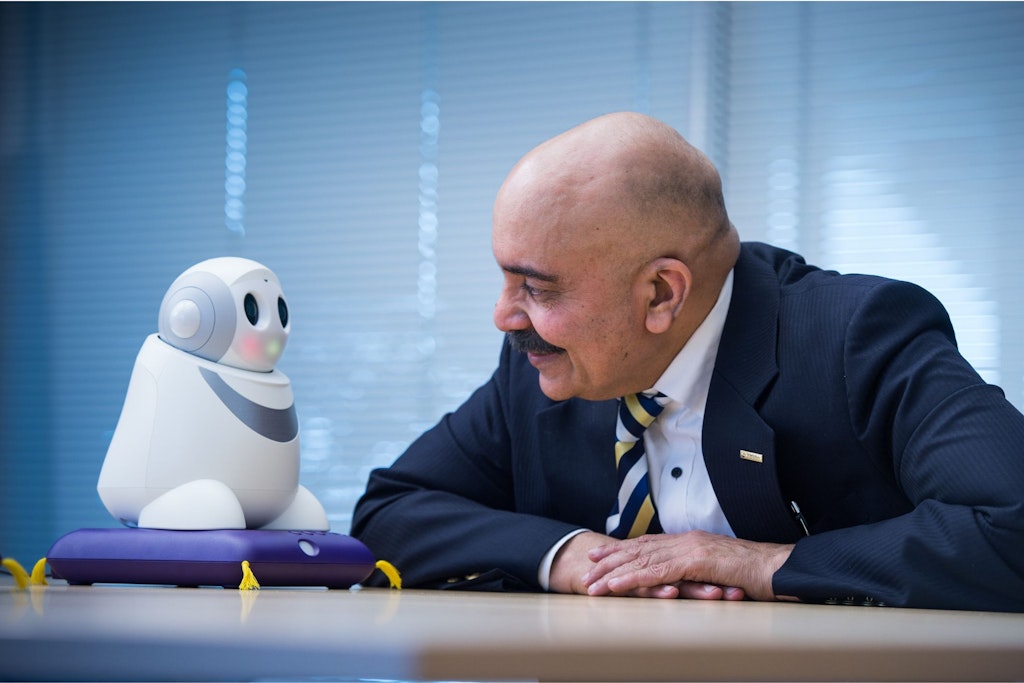Robots in aged care: the future is now
Last updated on 7 September 2023

In the not-so-distant future, humans and robots will coexist, learning from each other in a sustainable society. At least that’s the vision for Professor Rajiv Khosla, the face behind Matilda – an interactive, emotionally intelligent robot that has been built on human-centred design.
Matilda’s no stranger to aged care. She’s been trialled in countless homes and aged care settings over the past decade. The feedback? Wholly positive thanks to what Professor Khosla calls socially-responsible design. And in an industry where technology has been hard to adopt, partly because older residents can be wary of new things, Professor Khosla has a happy medium.
“My underpinning of Matilda has been human-centred design the whole time,” he explained. “That’s what drove me from artificial intelligence to human-centred design, to social design. Matilda provided a medium in which all social interactions could take place through a natural interface.”
“You could see that people who were averse to technology warmed up because when they saw her dancing or singing it brought out positive emotions. It brought back good memories, especially for people with dementia, and they developed a relationship.”
How exactly can a robot develop a relationship with people? Artificial intelligence. Matilda learns and can recognise instances of self-harm in people, and she’ll remember a person’s favourite musician to help prompt activity later on.
It’s just one way that robots are helping older people and if you look elsewhere, more robotic help is not just on the way, it’s here.
Robots embedded in everyday services
At Tanunda Lutheran Home (TLH) in South Australia’s Barossa Valley, signs alert people to robots working in the area, warning them to give way. They’re handy reminders of the three robots – Axil, Robbie and Speckle – working tirelessly to assist with everyday tasks. Two push trolleys around the home, transporting linen and food, while one cleans and disinfects major touchpoints using ultraviolet lighting.

Introducing robots came out of necessity. Staff were covering 9,000 kilometres per year pushing trolleys, an average of 24km a day. They were wearing themselves down while residents were missing out on direct care. That’s now changed.
“There’s less damage to the facility and environment, there’s reduced noise, reduced touch points, and reduced staff injuries,” TLH Chief Executive Officer (CEO) Lee Martin explained. “The fact that staff weren’t having to push trolleys reduced work cover through fewer shoulder, back, elbow and wrist injuries.”
“It also aids continuous improvement, assists in the control of food temperatures between the kitchen and rooms, and there’s the improved quality and timing of services which residents love. So when we were looking at costs we’re saving about $4.25 per resident per day which is about $200,000 a year.”
Mr Martin has gained close to 10 hours of meaningful work per day from his workforce. In addition, TLH recruits workers with the reassurance that there’s limited heavy pushing and lifting because the robots do it.
It’s not quite all smooth sailing as TLH is located in a 70-year-old building that was not designed for robots. Swinging doors had to be replaced with sliding doors and the lift had to be adjusted to accommodate the robots. That’s where patience has been important, and Mr Martin said it’s paid off through ongoing savings and staff retention.
“There is a level of patience one should take, including the expectations one has for the robots. I’ve been going through this process for three years and my expectations are just now being met,” he explained.
“Planning and timing is the big thing. In a new building, you can accommodate the technical and physical requirements of robots. You have to make allowances in an old building for all of that. A lot of technology is also required, and the environment needs to suit Wi-Fi requirements and the associated software.”
Looking to the future
Mr Martin has been incredibly active in robotics research and development outside of his organisation and work is underway to introduce new robots. Some will be more advanced versions of manual labour robots, but nursing support is not out of the question.
“I believe the aged care sector will gain a lot of kudos by using robots in the future,” Mr Martin said. “I’ve started sowing seeds that Aged Care Standards need to accept that robotics will come into the sector.”
Based on his experiences, Mr Martin is confident we’ll see robots right across aged care within the next three years. With the rapid advancement in artificial intelligence – as seen in Matilda – it’s likely that his other prediction of robots recognising and conversing with people is not far off.
“There certainly needs to be greater discussions regarding the training of clinical and aged care staff about working alongside robots; a level of investment in the legal and workforce implications, particularly around work health and safety; and investment in the nursing and medical sectors because I firmly believe that robots will be able to do some nursing technical work,” he added.
Matilda confirms that the future is now
Matilda is likely the first step towards what Mr Martin is after – robots that can provide nursing assistance. Although Matilda cannot provide physical support, she has the ability to monitor basic vital signs, make video/telehealth calls, operate as a smart home control and can even recognise changes in emotional and physical well-being by scanning the room.
Altogether, it’s an example of complex technology presented in an accessible format for older people. If more technology can be embedded into everyday life, by the time we’re all living in aged care, robots will just be a normal part of the workforce.